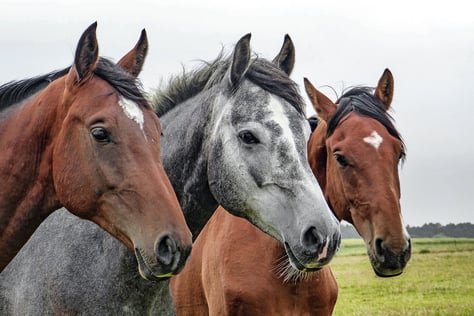Whether you’ve been around horses a long time and have lots of ideas from boarding stables or you are brand new to horses, building your own barn can be a challenge. Location, construction materials, stall types and amenities are all decisions to be made. There are literally hundreds of options when building your barn and we won’t be able to cover them all. But we’ll go over the most common types of barns and stalls as well as tips to remember before and during the construction process.
Before we even start, let’s just take a moment to decide if horse  keeping on your own property, especially if you're thinking of opening it to other boarders, is right for you. If you’ve never owned horses before, starting at a boarding stable with a knowledgeable barn manager, workers and trainers is a good option. You will have total responsibility for your horse and the horse's of others. Basic and special feeding, deworming schedules, getting horses ready for the vet or farrier, and basic wound care are all necessary skills. Since every horse is different, new horse owners often have questions about feed, shoeing and general health. It’s very helpful (and comforting) to know that there’s someone at the barn who can helps answer your questions. And they will look to you to be that person. In addition, you will be expected to have adequate coverage to look after the horses if you decide to go away for a few days.
keeping on your own property, especially if you're thinking of opening it to other boarders, is right for you. If you’ve never owned horses before, starting at a boarding stable with a knowledgeable barn manager, workers and trainers is a good option. You will have total responsibility for your horse and the horse's of others. Basic and special feeding, deworming schedules, getting horses ready for the vet or farrier, and basic wound care are all necessary skills. Since every horse is different, new horse owners often have questions about feed, shoeing and general health. It’s very helpful (and comforting) to know that there’s someone at the barn who can helps answer your questions. And they will look to you to be that person. In addition, you will be expected to have adequate coverage to look after the horses if you decide to go away for a few days.
Another consideration of keeping horses at your barn is cost of supplies. Remember that large boarding stables often buy hay and bedding in bulk because they have the room to store it. This help keeps cost down.
Vet visits are another cost that can be reduced with other horse owners. Vets charge a “farm call” fee in addition to any medical treatment. With a large stable full of horses, there is usually someone else at the barn who’d like to talk to the vet or have him take a look at their horse while he’s there. You can usually split the farm visit fee with another boarder. Spring /fall shots and dental visits are another way to save money. Boarding stables often have “shot clinics” where the vet comes out and all the shots are done at one time. The same is true for dental work. Again, this saves you the cost of the farm call fee.
Finally, farrier services can be difficult to find if you only have one or two horses and live in a remote location. Farriers often like to work at stables where they can go to just one place, set up once and shoe numerous horses. It may not be worth his time to have you as a client if most of it is spent driving to and from your barn for just a few hoof trims.
Finally, there’s the camaraderie principle. This doesn’t have a cost, but after a few months of keeping horses at home, you may find you miss the social aspect of being at a barn. It’s nice to talk to someone after a good lesson or have a shoulder to cry on after a bad one. On the other hand, if you are the barn owner or manager, your privacy will be in jeopardy as clients feel free to stop by your home at any time.
If boarding horses at your home still sounds like a good idea, the next step is doing a business plan. It's a necessary step to ensuring that your barn is a success. We'll tell you more about how to do create basic and easy next time.



